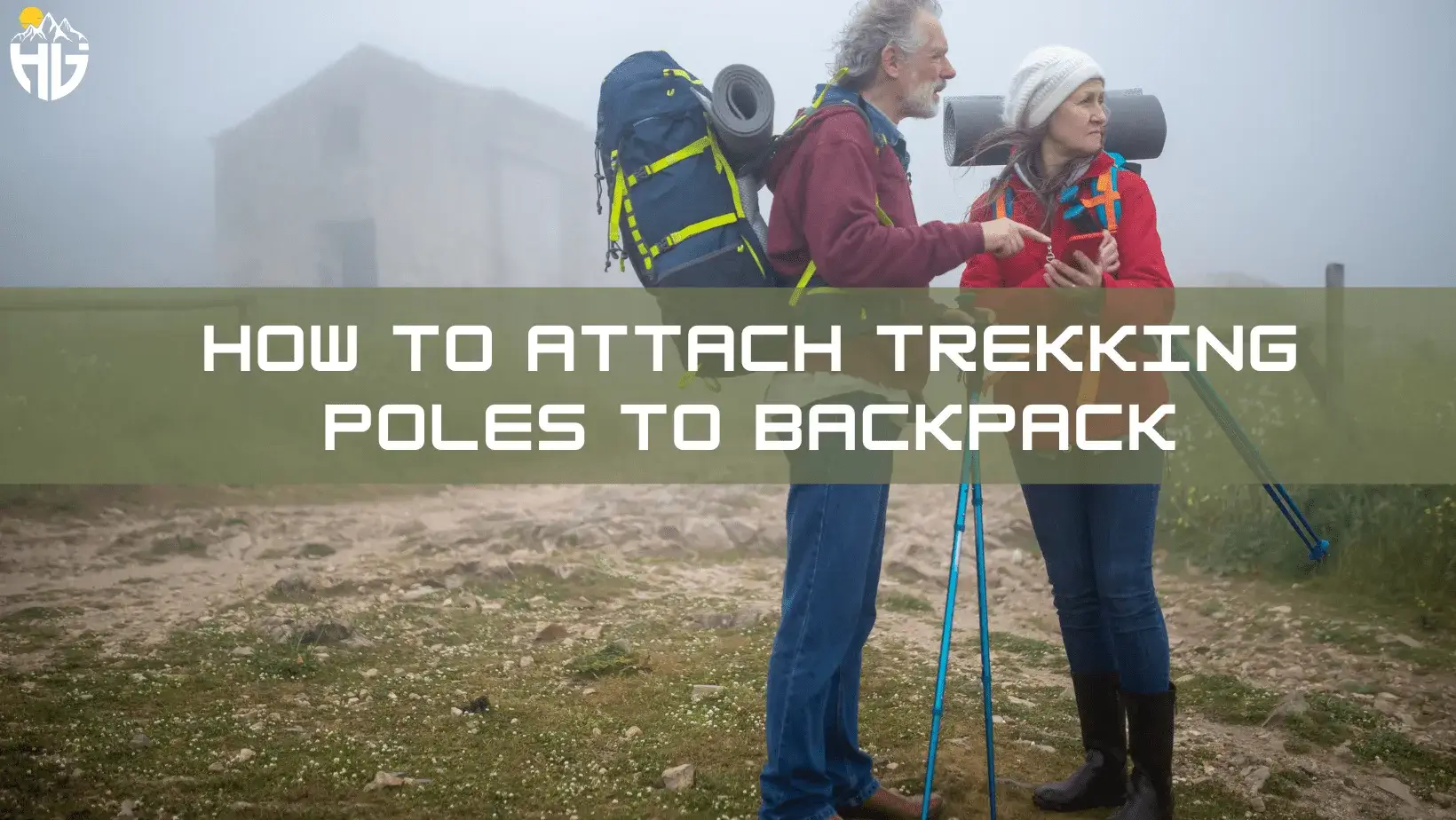How To Size Trekking Poles?

To measure the correct size for your trekking poles, start by standing upright in the shoes you intend to wear while hiking. Grip the pole near the top and bend your elbow at a 90-degree angle.
Adjust the pole’s length until your forearm becomes parallel to the ground. Most of it have adjustable sections, so make sure they are securely locked in place. It’s essential to test the length on various terrains to fine-tune it as needed.
Shorten the poles for uphill climbs to improve stability and reduce strain, and lengthen them for downhill descents to maintain balance and control.
Individual Height And Trekking Pole Height chart

You can determine that how long a trekking pole you should use from given chart:
| User’s height | Trekking Poles Size |
| Below 5’1″ | 100-110 cm |
| 5’1″ – 5’7″ | 110-120 cm |
| 5’8″ – 5’11” | 120-130 cm |
| 6’0″ – 6’3 | 130-140 cm |
| Above 6’3″ | 140-150 cm or more |
How To Size Trekking Poles
Sizing trekking poles is a crucial step to ensure your comfort, stability, and efficiency while hiking.
Here’s a comprehensive guide on how you get size of it like a seasoned hiking expert:
Selecting the Right Poles
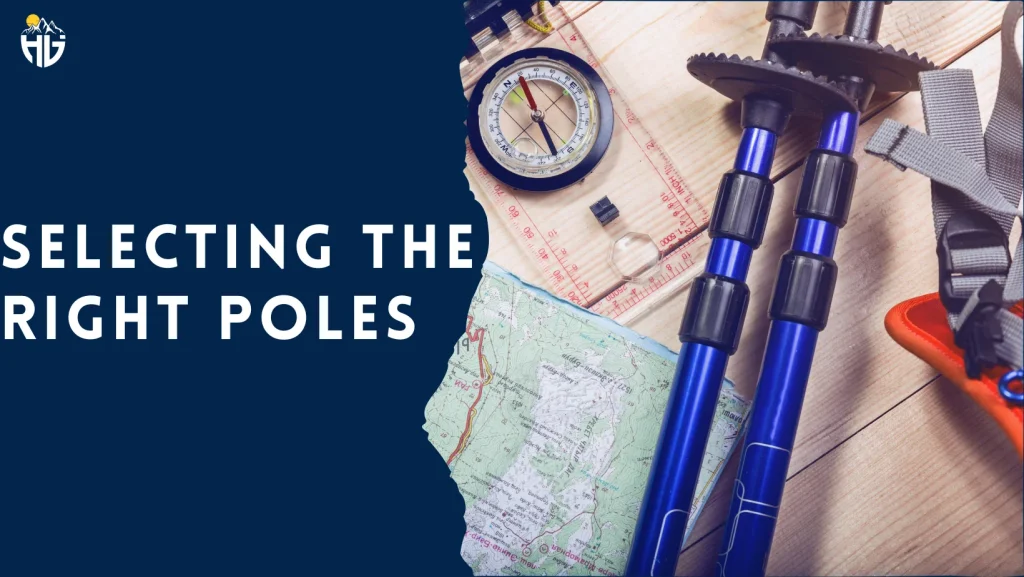
Consider factors like material (aluminium for durability, carbon fibre for lightweight), collapsibility (three-section poles for portability, two-section for strength), and grip type (cork for comfort, foam for moisture resistance).
Stand Upright in Hiking Gear

Put on your hiking shoes and any additional gear you typically wear during your hikes. Stand up straight on a flat surface to simulate hiking conditions.
Grip Adjustment

Hold the hiking stick with the grip near the top, allowing your forearm to hang vertically along your body. Your arm should form a right angle at the elbow.
Adjust Pole Length
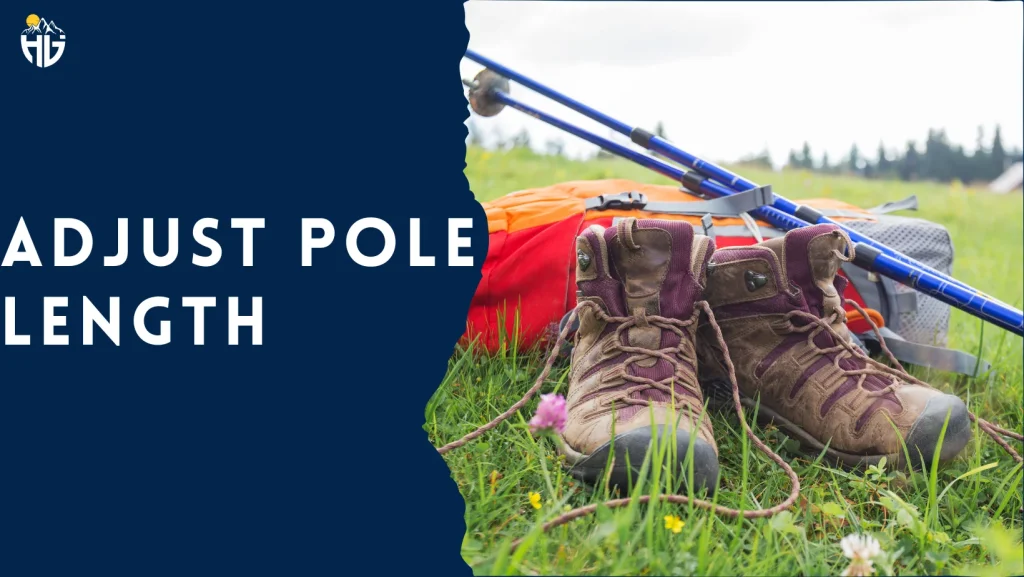
Extend or retract the pole sections to adjust their length. Most of it have telescopic sections with locking mechanisms. Start by adjusting one pole to the desired length.
Fine-Tuning Length

The pole should provide support without you having to lean excessively. If it feels too short or long, make further adjustments. It’s a good practice to slightly lengthen the pole for downhill sections and shorten it for uphill climbs.
Test on Various Terrains

Test your pole length on different terrains, including flat trails, ascents, descents, and uneven surfaces. The right size of trekking poles you need, provides stability and helps distribute your weight evenly.
Comfort and Ergonomics

Pay attention to the grip and strap. The grip should feel comfortable in your hand, and the strap should support your wrist without causing discomfort.
Pair Adjustment
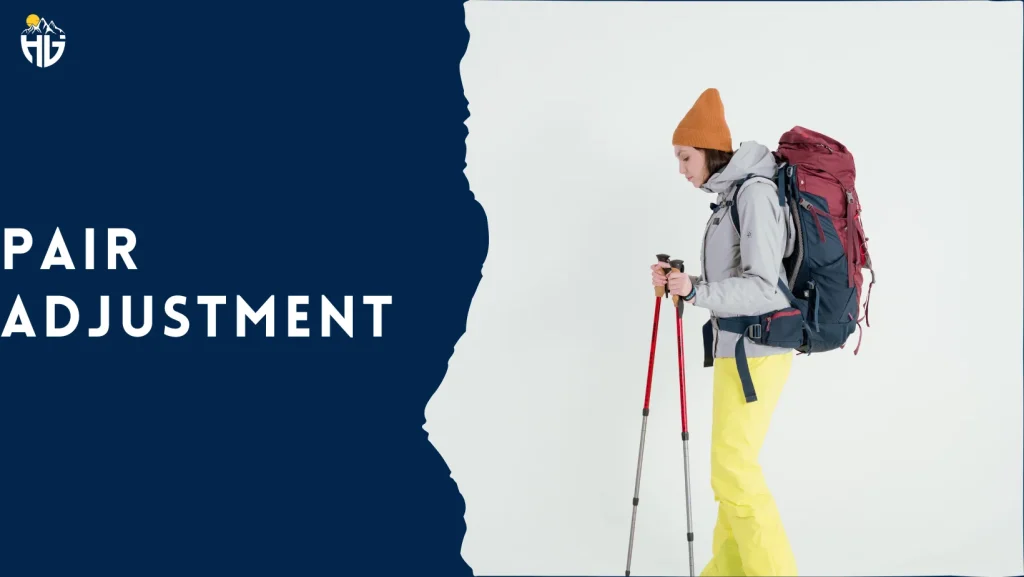
Repeat the same process for the second pole, ensuring it matches the length of the first. Trekking with poles of uneven lengths can lead to imbalance.
Regular Reassessment
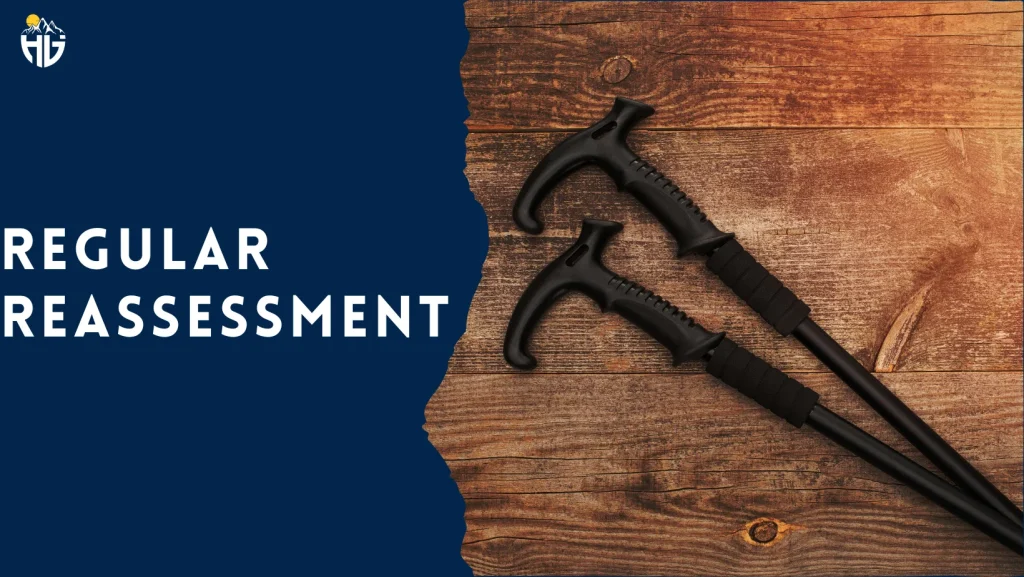
Don’t hesitate to make minor length and size adjustments as needed to optimise your trekking poles performance throughout your hike.
Trekking Pole Locking Mechanism

Understanding these mechanisms is crucial for a safe and comfortable hiking experience. Here’s a comprehensive guide to the most common trekking pole locking mechanisms:
Twist Locks
- These locks require you to twist one pole section clockwise or counterclockwise to tighten or loosen it. They usually have an external threaded mechanism.
- Simple to use, easy to maintain, and provide a strong hold.
- But may require more effort to adjust than other mechanisms and can be susceptible to dirt or debris.
Lever Locks
- Lever locks use a clamp or lever system to secure pole sections in place. They often have a push-button release for adjustment.
- Quick and easy to adjust, even with gloves, and tend to be more durable than twist locks.
- Slightly heavier and bulkier than twist locks.
Push-Button Locks
- Push-button locks are typically found on telescopic poles. Pressing the button allows you to adjust the length of the pole sections.
- Quick and secure adjustments, often lightweight, and suitable for collapsible poles.
- Less common than twist and lever locks, and may not be as sturdy for heavy-duty use.
External Locks
- External locks are located outside the pole, making them easy to access. They often use twist or lever mechanisms.
- Simple to operate and adjust on the fly.
- More exposed to dirt and damage compared to internal locks.
Also Read
Internal Locks
- Internal locks are concealed within the pole sections, providing protection against external elements.
- Less prone to dirt and damage, ideal for challenging terrains.
- May be slightly more challenging to adjust.
Importance of Trekking Pole Locking Mechanisms
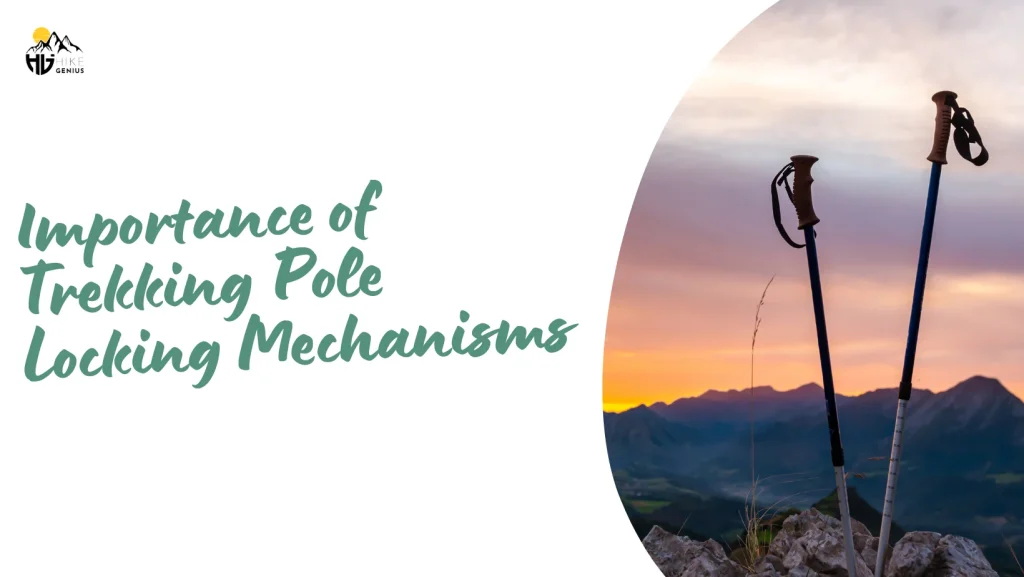
Proper locking mechanisms are essential for several reasons:
Safety
Securely locked poles ensure stability and prevent sudden collapses, reducing the risk of injury on the trail.
Comfort
The ability to adjust ‘trekking poles size easily helps maintain proper posture and balance, reducing strain on your joints.
Versatility
Different terrains and hiking scenarios may require adjusting pole length. Efficient locking mechanisms facilitate quick changes as needed.
Durability
Quality locking mechanisms ensure your poles stay in place under stress, improving the longevity of it.
Ease of Use
The right locking mechanism should be user-friendly and easy to operate, especially in adverse weather conditions.
Features of Good Trekking Pole
When selecting poles, consider the following features to ensure they meet your specific needs and preferences:
Material
Aluminium: Durable and cost-effective, suitable for most hikers.
Carbon Fibre: Lightweight and strong but more expensive.
Number of Sections
Two-Section: Sturdy and simple, ideal for rugged terrain.
Three-Section: Adjustable for various terrains and more portable.
Grip Type
Cork: Comfortable, moisture-wicking, and conforms to your hand’s shape.
Foam: Provides cushioning and insulation.
Rubber: Offers a secure grip in wet conditions.
Strap Design
- Adjustable straps for a customised fit.
- Padded or moisture-wicking straps for added comfort.
Shock Absorption
Built-in systems reduce impact on wrists and arms, beneficial for rocky terrain.
Weight
Lighter poles are more comfortable for extended hikes but may sacrifice some durability.
Tip Material
- Tungsten carbide tips for durability on rocky terrain.
- Rubber tips for grip on hard surfaces and reducing noise.
Benefits of using Trekking Pole

It offer several important benefits that can enhance your hiking and outdoor experiences:
- Trekking poles provide extra points of contact with the ground, improving your balance and stability, especially on uneven or challenging terrain. This helps prevent slips and falls, reducing the risk of injury.
- When hiking downhill or on hard surfaces, it helps absorb some of the impact that would otherwise be absorbed by your knees and joints. This can significantly reduce joint strain and discomfort, making long hikes more enjoyable.
- Using trekking poles encourages an upright posture. This not only reduces strain on your back but also helps with breathing and overall endurance, especially during steep ascents.
- With it, you can push off the ground more efficiently, increasing your walking speed and covering more ground with less effort.
- It helps distribute your weight more evenly between your upper and lower body. This can reduce fatigue and muscle soreness, allowing you to hike longer and farther.
- On long hikes, trekking poles can take some of the load off your legs, reducing muscle fatigue and allowing you to maintain a more consistent pace.
Conclusion
They are not just handy accessories for hikers; they are invaluable tools that enhance stability, reduce strain, and provide added safety on the trail.
Whether you’re conquering steep ascents, navigating tricky descents, or simply enjoying a leisurely hike, these versatile poles can significantly improve your overall outdoor experience.
By choosing the right poles and using them effectively, you can hike with greater comfort, confidence, and endurance, ultimately allowing you to explore and enjoy the wonders of nature to the fullest.


